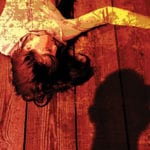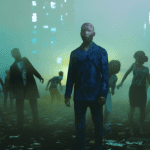 Technology
Technology  Technology
Technology  Misconceptions
Misconceptions 10 Hilarious (and Totally Wrong) Misconceptions About Childbirth
 Weird Stuff
Weird Stuff 10 Warning Labels That Exist Because Someone Actually Tried It
 Health
Health Ten Confounding New Inventions from the World of Biomedicine
 Creepy
Creepy 10 Death Superstitions That Will Give You the Creeps
 Movies and TV
Movies and TV 10 Movies That Get Elite Jobs Right, According to Experts
 Weird Stuff
Weird Stuff 10 Times Real Laws Were Based on Bizarre Hypotheticals
 Animals
Animals 10 Inspiring Tales of Horses Being Human
 Mysteries
Mysteries Top 10 Haunting Facts About the Ghost Ship MV Alta
 History
History 10 Surprising Stories About the Texas Rangers
 Technology
Technology 10 Awesome Upgrades to Common Household Items
 Misconceptions
Misconceptions 10 Hilarious (and Totally Wrong) Misconceptions About Childbirth
 Weird Stuff
Weird Stuff 10 Warning Labels That Exist Because Someone Actually Tried It
Who's Behind Listverse?

Jamie Frater
Head Editor
Jamie founded Listverse due to an insatiable desire to share fascinating, obscure, and bizarre facts. He has been a guest speaker on numerous national radio and television stations and is a five time published author.
More About Us Health
Health Ten Confounding New Inventions from the World of Biomedicine
 Creepy
Creepy 10 Death Superstitions That Will Give You the Creeps
 Movies and TV
Movies and TV 10 Movies That Get Elite Jobs Right, According to Experts
 Weird Stuff
Weird Stuff 10 Times Real Laws Were Based on Bizarre Hypotheticals
 Animals
Animals 10 Inspiring Tales of Horses Being Human
 Mysteries
Mysteries Top 10 Haunting Facts About the Ghost Ship MV Alta
 History
History 10 Surprising Stories About the Texas Rangers
Top 10 Horror Novels to Read This Sweltering Summer
Summer rolling in signals the arrival of BBQs, beach days, ice cream, and camping. For many people, the spookiness of Halloween seems far off, but horror authors like to take these simple summer pleasures and turn them into something sinister. From kids battling evil over summer break to creatures terrorizing sunny seaside towns, mixing horror with summer can have terrifying results.
When enjoying the sunshine, people often reach for light romances or fast thrillers, but if you’re a horror fan and like to read with the seasons, then here are 10 horror books that fully embrace the heat of summer.
Related: 10 Crazy Theories About Popular Horror Movies
10 Jaws (1974)
Peter Benchley
Jaws is best known for its 1975 movie adaptation directed by Steven Spielberg, but the book itself made a splash at the time. Despite being a bestseller, critical opinion was mixed. Alongside the main plot about the shark attacking the seaside town of Amity, readers were subjected to subplots concerning the personal dramas of the town’s residents. Reviewing the book for Time, John Skow thought that these “events simply refuse to take on life and momentum.” For the film, the plot was stripped down to its core, focusing on the three men who attempt to kill the great white.
Don Kaye of Den of Geek describes the novel as a fun “summer read” but acknowledges that “it’s the movie version of Jaws that has been more fully imprinted in our cultural memory.” It is now known that sharks usually only attack humans when they mistake them for their regular prey (which rarely happens). Benchley is now an advocate for shark conservation, and he admits that he “couldn’t possibly write Jaws today… not in good conscience anyway.” Armed with this knowledge, readers can feel safe reading Jaws at the beach before going for a swim.[1]
9 Camp Slaughter (2019)
Sergio Gomez
Camp Slaughter is the novel you get if you blend The Texas Chainsaw Massacre (1974) together with Friday the 13th (1980). It follows a group of college kids who are staying—and partying—at a remote cabin in the Pennsylvanian woods, as well as a pair of documentary filmmakers seeking out supernatural mysteries. Unbeknown to both groups, a killer cannibal calls these woods home.
Once the inevitable killing starts, the gore is excessively and entertainingly over-the-top. The splattering of blood is broken up with plenty of moments of comic relief, lending the book a fun rather than serious tone. Camp Slaughter plays into the expected tropes of the slasher sub-genre, with deaths that are frequent and brutal. Heads are crushed, and necks are slashed. The killer is also surprisingly fleshed out for a book that is essentially a campfire story about bloody carnage in the woods.[2]
8 The Troop (2014)
Nick Cutter
The events of The Troop technically take place in October, but it follows a Scoutmaster taking a group of Boy Scouts on a camping excursion to an uninhabited island, making it feel like a summer novel. The horror comes in the form of the arrival of a skeletal, starving, and deranged man who carries a mysterious infection. Nick Cutter, a pen name for Craig Davidson, chops up the intense horrors that follow with interviews and newspaper clippings that are reminiscent of King’s Carrie (1974).
Kirkus Reviews declares that The Troop “packs a powerful punch by plunging readers into gut-wrenching, explicit imagery that’s not for the faint of heart or the weak of stomach.” Cutter’s grotesque body horror will definitely have you putting down your snacks as the disgusting descriptions worm their way into your brain. The Troop is proof that gruesome descriptions on the page can be just as effective as onscreen visuals. Cutter’s novel is currently being adapted into a movie, with E.L. Katz set to direct.[3]
7 Ghost Summer: Stories (2015)
Tananarive Due
Tananarive Due’s short story collection Ghost Summer isn’t entirely rooted in the summer season, but many of the stories do have a flavor of summer. The titular story is about a boy who visits his grandparents for the summer in Gracetown—a place where children can see ghosts. “The Lake,” another summery story that is also set in Gracetown, follows a schoolteacher who finds herself drawn to the unearthly lake behind her house. The other stories in the collection deal with everything from zombies to precognition.
Due’s stories often mix classic monsters with real-life horrors, from the struggles of parenthood to the difficulties of the Underground Railroad. A review for the New York Journal of Books explains that Ghost Summer isn’t excessively gruesome; rather, its introspective tales “wind readers down a lovely meandering path of curiosity and subtle dread before they find they are lost inescapably in some dark forest with a menacing breath coming from over their shoulder.”[4]
6 Cold Moon Over Babylon (1980)
Michael McDowell
A few of Michael McDowell’s Southern Gothic horror novels are suffused with summer vibes, particularly Cold Moon Over Babylon and The Elementals (1981). The latter is about an abandoned (and haunted) summer house on the beach; the former is a revenge ghost story. Cold Moon is set in the small town of Babylon, located on the border between Florida and Alabama, and the southern heat can be felt on every page.
Tragedy strikes Babylon when teenager Margaret Larkin is murdered, and her body is found in the Styx River. The murderer seems to have gotten away with it, but when earthly justice is not served, a supernatural presence steps in. McDowell’s novel is sometimes brutally gruesome and, at other times, chillingly haunting. Publishers Weekly warned: “Readers of weak constitution should beware.” In 2016, a film adaptation, Cold Moon, was released, which Variety described as “goofy, but juicy.”[5]
5 The Forgotten Island (2018)
David Sodergren
Lovers of slasher and creature-feature B-movies need to read David Sodergren’s books. His first novel, The Forgotten Island, follows estranged sisters Ana and Rachel as they try to reconnect on a holiday to Thailand. After a night of drunken partying, the sisters and the rest of their group wind up on a condemned island. There’s sunshine and beaches, but the island is cut off from civilization and is covered in a thick jungle where something sinister is lurking.
Author James Fahy describes The Forgotten Island as “a blood-drenched love letter to Lovecraft,” which doesn’t “hold back on the splatter factor.” Along with the Lovecraftian element, the novel also pays homage to the horror movies of the ’80s, and like those films, it delights in spilling the blood of its often deliberately irritating characters. The Forgotten Island is action-packed, gore-filled, and laugh-out-loud funny. Reading about these characters’ fight for survival will make you glad you aren’t trapped on a forsaken island.[6]
4 Until Summer Comes Around (2020)
Glenn Rolfe
The Lost Boys (1987) is a classic summer horror movie, mixing the beach town atmosphere of the fictional Santa Carla, California, with the sharp teeth of a vampire tale. In Until Summer Comes Around, Glenn Rolfe takes this winning combination and makes it his own. Set in 1986 in the real resort town of Old Orchard Beach, Maine, Rolfe’s novel follows teenager Rocky as he falls in love with a mysterious girl called November. But their summer romance is threatened by November’s brother, Gabriel, whose bloodlust is growing.
There is a hefty dose of nostalgia in this book because of the time period and setting, but it never overwhelms the story itself. The descriptions of the seaside carnival and video game arcades serve to evocatively set the scene. Rocky’s coming-of-age arc is sympathetically awkward, and the situation he finds himself in (being warned off of a girl by her older brother) is given extra bite by the vampire element. Alongside this, the reader follows Gabriel’s blood-drenched nocturnal carnage in all of its visceral detail.[7]
3 The Ruins (2006)
Scott Smith
The Ruins blends eco-horror with survival horror. It follows a group of tourists on holiday in Mexico who travel to the site of an archeological dig in the jungle, where their adventure quickly takes a dark turn. They are trapped at the site by the local villagers, who refuse to let them leave. With the sun beating down and food and water in limited supply, the group realizes there may be an even greater danger. Hint: watch out for the plants.
Smith’s novel is presented without chapters, giving the feeling that the characters are relentlessly assaulted by the baking sun and Mexican flora. Stephen King declared that Smith’s novel “does for Mexican vacations what Jaws did for New England beaches in 1975.” The David Cronenberg-esque body horror throughout will certainly put you off venturing into the jungle. In 2008, a movie adaptation was released, and while it is suitably gory, it generally received poor reviews. Read the book instead.[8]
2 Summer of Night (1991)
Dan Simmons
Much like Stephen King’s It, Dan Simmons’s Summer of Night mixes horror with a coming-of-age story set during summer break. Simmons’s novel takes place in 1960 in the town of Elm Haven, Illinois, and follows five preteens who are grappling with the struggles of growing up. One of their classmates disappears on the last day of school, and other strange things begin to occur around the town. Finally, the boys realize that it is up to them to stop the mysterious evil that is emanating from the Old Central School.
Summer of Night takes place during the kind of lazy summer days that are supposed to be carefree, but the evil that is spreading forces the group of boys to take responsibility. Simmons slowly builds to the reveal of the darkness taking over the Midwestern town, making the reader question whether it is demons or ghosts or something else entirely. Adult versions of the boys can be found in the novels Children of the Night (1992), Fires of Eden (1994), and A Winter Haunting (2002).[9]
1 It (1986)
Stephen King
A number of King’s stories are set amid the heat of summer: the pandemic in The Stand (1978) kicks off during the summer; in Cujo (1981), a rabid dog traps a mother and son in a boiling hot car; and much of It takes place during summer break. In a list of the best King books, Rolling Stone ranks It at number 2. One of the things that makes It so popular is how well it not only captures childhood fears but also childhood friendships. There is the otherworldly threat of Pennywise and his various terrifying guises, as well as the very real threat of sadistic bullies. But at the heart of the novel lies the bond between The Losers Club.
The ’50s sections of the book, which follow the Losers on their summer adventures and misadventures, capture the childhood feeling of summers being endless. When the Losers reunite in the ’80s to confront Pennywise, their return to Derry also allows them to reflect on their childhood. Author Grady Hendrix states that it captures “some intangible feeling about growing up and saying goodbye.” King’s mammoth novel has been adapted twice, first as a miniseries in 1990 and then as a film duology, with the installments released in 2017 and 2019.[10]








